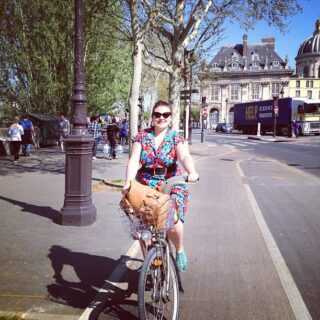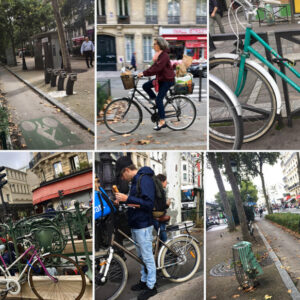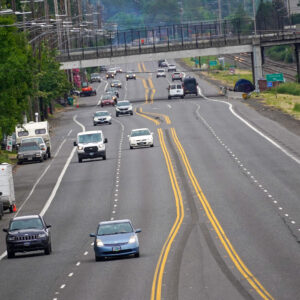
(Photos: Maritza Arango).
This is how I navigated my student in Paris years being a full-time bike and public transport commuter without having my own bike and without draining my student bank account. When I was in school I could get around the city without using a car or a bus.
The later the night gets, the drunker the people are on those buses. Another reason to use the bike share system and avoid the cold and creepy bus station.
The “City of Lights” is a great city for biking along the Seine River and the multicultural neighborhoods, while avoiding its dark side: the crowded, dirty and sometimes dangerous public transportation system.
Whenever I hear people speak about Paris they mention the marvels of the city, the cultural heritage, the museums, the food and all the positive and beautiful things the city has to offer. When I mention that I spent almost six years living in the city and then decided to move back to Colombia and now to the United States, I always get surprising comments about how sad and wrong it was for me to leave such an amazing place. What people don’t know (and never ask about) is that Paris is one of the most expensive cities in the world. It’s also a city that can be very aggressive towards women on streets and public transportation — which one of the main reasons why I used the public bike system almost all the time.
Advertisement
Paris is a party city that stays up very late, every day, all year long. Unfortunately, the metro or other public transport don’t work late, leaving people the only option of using the night bus — or the “nightmare” like some people, especially women, call it. The later the night gets, the drunker the people are on those buses. Another reason to use the bike share system and avoid the cold and creepy bus station.
When I was a student between 2010 and 2015, I used to pay €30 (about $35) a month for my Régie Autonome des Transports Parisiens (RATP) card. RATP runs the Paris transport system that includes the Metro (subway), tram, suburban express trains, bus and the “Noctilien” (night bus). The price I used to pay included unlimited rides on all the RATP services. As part of my student benefits, this card also included the unlimited Vélib’ bike service.
Vélib’ is a public bike share system that offers “Bikes for everyone”. And it lives up to that claim. There are 1,400 docking stations and 20,000 bikes (35% of which are electric). As of 2020 there were 400,000 Velib subscribers who make about 5.5 million trips every month. The one-day trip record was 215,000 on September 11th, 2020.
[Postcards from Paris: Mixtes, street scenes, and a budding bike network (2017)]
When I moved to Portland earlier this year, the idea of having access to a public bike service again was very exciting. I quickly discovered that the system works very differently and that it is not at all a bike system for everyone. With no doubt, Portland’s Biketown offers a great solution for sporadic rides when my bike is not working, or when someone that doesn’t have a bike needs one, or for tourists to discover the city; but I still wonder how accessible it really is.
It’s true that Biketown is not a public transport service like Velib is (even though the latter was a major influence on the former, as our post from 2007 points out). Biketown is a private service that occupies the public space. For that reason, I still remember those university years when biking was part of my public services. And when not just me, but thousands of other Parisians, could benefit from having an amazingly accessible bike service. I look forward to the day when Portland and Oregon (and the U.S.!) can create a difference in how easily people — especially those who can’t afford a bicycle or Biketown rental rates — can get access to a public bike. This is not just a way of giving affordable access to biking to everyone, it’s also a huge step to creating a more responsible and sustainable public transportation system.
Bravo les français, qu’est ce-que j’aime une Vélib’!
— Maritza Arango, @arango_mari on Instagram, Twitter and TikTok.
— Get our headlines delivered to your inbox.
— Please support this independent community media outlet with a one-time contribution or monthly subscription.





Thanks for reading.
BikePortland has served this community with independent community journalism since 2005. We rely on subscriptions from readers like you to survive. Your financial support is vital in keeping this valuable resource alive and well.
Please subscribe today to strengthen and expand our work.
I would love to hear more about how Biketown could be made more like the bikeshare in Paris
I doubt it’s possible under the current regime since Nike is the main sponsor. Pretty sure their contract is exclusive too.. meaning unlike e-scooters, Portland can’t have another bike share competitor come into the market. This is really a cultural issue. Americans just don’t believe in public transport the way Europeans do. It was a big political lift to even get the $2 million kickstart for Biketown. It would take a shift in approach and culture for the public/media not to freak out about a new, truly public and cheap, bike share system. Could happen! We just need someone to put it all together.
It is not only public transportation that Americans don’t embrace. It is an entire concept that society is joined in a social contract to provide the public good. When I toured in Germany paved trails went through private land through corn fields and wood lots. That is nearly inconceivable in NIMBY America. FWIW Germans are capitalists.
This is not a capitalist concept.
I’d expand on this and on the idea of public transportation systems but BikePortland has an automoderate feature that zaps comments that are even slightly to the l*ft of Nixon (the “s” and “c” word trigger this in my case).
What would it take, do you think, to get Biketown to expand its service area to include Beaverton? So one could ride a Biketown bike to, say, the main sponsor’s Beaverton campus?
A lot of changes on West Burnside, Skyline Blvd, SW Scholls Ferry Road, BHH, and Canyon Road would be needed. ODOT is considering adding at least one bike lane in a year or so on Canyon from about SW 87th Avenue to near the path that goes to SW Raab Road. It is “highway” 8.
The service area seems to be overlapping a lot with the best public transit service areas, which kind of reduces utility. I live in Woodstock/Mt. Scott area and if I could take a biketown bike to the Max that would be great, but I have to walk nearly a mile to get the bike, so I just take my own bike. I’d love to not have to bring my bike on the train.
I still am unsure what distinction you have in mind that makes Velib “public” and Biketown not so much? Rates? Membership?
Well I guess technically “public” is a term of art in this context. Velib isn’t owned by the City of Paris and it’s essentially a private company just like Biketown… But in looks and acts much more like a true public service than Biketown. That’s because Paris couldn’t likely function without it. And yes, it’s a near ubiquitous amenity with a ridership to match. And yes, FWIW it is much simpler to find one and much cheaper to ride than Biketown.
Good post! It’s really interested for me to know the difference between Paris and Portland rides. I really enjoy spending my time biking around Portland. I ❤️ Portland and their bike rides ⛰ it was also good to know the another face of Paris.